Sport - Interview
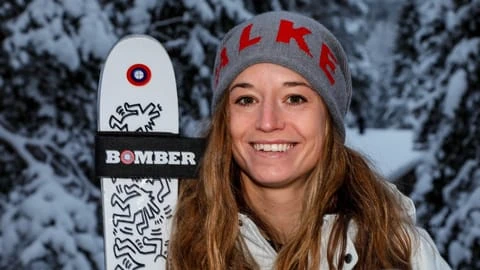
Interview with Laura Grasemann, 11 times German National Champion Freestyle Mogul Skier
Sport - Interview
by Meryem Aksoy
Laura Grasemann has started skiing when she was 7 years old. Her love and passion for skiing carried her to the German National Team in a short period of time. In 2007, she participated in her first international competition and since then she has been competing in international competitions including the Olympics and World Championships. Laura is a professional Freestyle Mogul skier who has won German National Championship 11 times, but despite this, she has experienced financial problems about continuing her career in different stages of her life. I think she is one of the most experienced athletes who I can talk about the importance of sponsorship. And I had the opportunity to talk with Laura Grasemann in order to learn about her career and her opinions about the importance of individual sponsorship in freestyle skiing.
Laura, what does skiing means for you?
Skiing is a passion and a profession at the same time. It’s a childhood dream and a goal I’ve been working for since I was a child. There is nothing else that feels more like the freedom to me than standing on top of a mountain with skis under my feet.
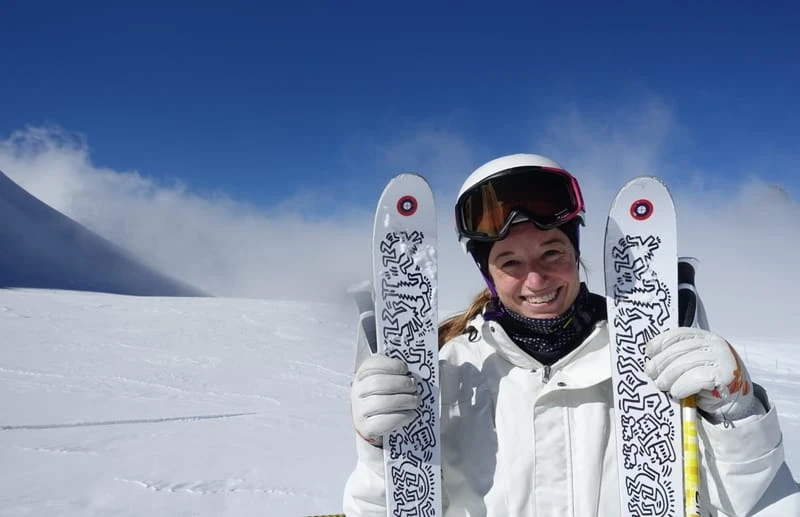
Laura Grasemann
How did you discover the skiing passion that takes you to the snowy hills? Why did you prefer freestyle skiing?
I think I loved skiing from the moment I did it for the first time. When I was 7 years old, my parents took me to the local ski club. That’s probably where and when my passion and aims developed. We were a whole bunch of children having fun skiing together. We did nearly every kind of skiing; alpine skiing, freeriding, freeskiing, and of course mogul skiing. I stuck to that because I like the combination of technically challenging skiing combined with acrobatic jumps. Probably, I was influenced by my coach Klaus Weese, who himself went to the Olympic Winter games in mogul skiing twice.

Laura Grasemann - Photo by Harald Marbler
Could you tell us about yourself and your freestyle skiing / Moguls career?
Growing up near Heidelberg, Germany, a place pretty far away from the mountains with hardly any snow, it was not self-evident to become a professional skier. However, it has always been a dream to participate in the World Cup, and so I didn’t listen to what seemed to be impossible. I had a lot of fun skiing, and I never quit persuading my dream. So one thing leads to another, and I made it from national kids races to national Junior races and in 2006, at the age of 14, I qualified for the German National team. I skied my first international competitions in Europa Cup, and in 2008, my childhood dream came true: I skied my first ever World Cup. In 2014, I skied in the Olympics in Sochi. But, as always and everywhere in life, there are ups and downs. Deceptions are always followed by success, and the other way round. I achieved my best result so far, ending up on the podium in a World Cup in Japan, just after missing the qualification for the 2018 Olympic Games.

Laura Grasemann - Tazawako moguls World Cup � (c) FIS Freestyle
You are an Olympic Athlete and you have a lot of national and international success in your career. Could you tell us about your achievements?
My greatest achievement in sports is a third place in the 2018 World Cup in Tazawako, Japan, followed by a fourth place in the next competition during World Cup finals in Megève, France. I am currently ranked 9th in the World rank list according to FIS points. I have several top 10 results in World Cup, the 9th place in World Championships 2015 in Kreischberg (Dual Moguls), Austria, and two 11th positions for World championships, 2015 in Kreischberg (Moguls), and 2017 in Sierra Nevada, in Spain. I am 11x German champion, and in 2014 I skied in the Olympic Winter Games in Sochi.

Laura Grasemann
Besides this successful career, you are a Student of Molecular Biotechnology (Master program). How do you balance your life between freestyle skiing and education?
Most important to succeed in both careers is, to find the right balance and timing in prioritization. There are points in life, where the main focus is on skiing, and then it switches towards education. It is crucial to be aware of the fact that one only has a hundred percent to give, and it is not possible to give a hundred percent for both careers at the same time. Switching focus keeps both “professions” in my life interesting. When I go skiing after some time of studying, I am highly motivated, and super excited, which may result in greater progress. On the other side, after a long season, I am glad to go back to university to my studies. I would see the chance to balance two careers as an opportunity rather than a burden. Last but not least, it is extremely important to keep time for myself, to do things that neither have anything to do with skiing nor anything with education. This quality time is crucial to "refuel" and regain the strength to continue with the same enthusiasm.
What are the basic financial problems that freestyle skiers have been living during their freestyle skiing career?
For freestyle skiers, conditions vary greatly depending on where you are from. Plain results, in contrast, don’t make any difference between how much effort a certain athlete had to make in order to achieve the same result. The athlete that had to struggle for every cent is compared to the one that had everything he or she needed to get to that certain point. Very few people care about challenges that have to be overcome, most focus solely on the result.
Skiing, in general, is an expensive sport. At a young age, you have to spend lots of money mainly on equipment, travel costs and ski passes. Parents have to drive you to ski resorts, and whole families are involved in an individual’s career. Over time, the amount of costs you spend on different things change. Later on, you will spend less amount on equipment but travelling gets more and more expensive.
In Germany, mogul skiing is not funded. We have to finance everything on our own, starting from expenses for coaches and staff, for travels, starting fees, lodging, or expenses for equipment, if you don’t have any sponsors. This is, fortunately, a quite rare occasion. I, personally, spend around 30 000 € per season. It is a challenge to get hold of such a lot of money. Besides skiing and studying, I have to look and take care of sponsors and supporters, in order to finance my sport. Instead of fully focusing on my skiing, I have to make up plans and considerations on how to spend the money I have available, and how to finance the next season. Still, I am far beyond having the resources and possibilities other athletes have.
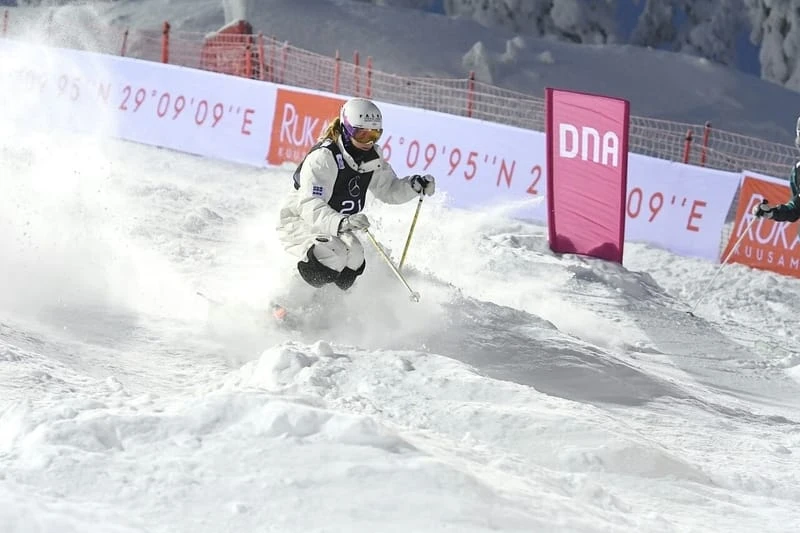
Laura Grasemann - Photo by Petri Voutillainen
How could freestyle skiers solve these problems? What is the permanent solution?
In my opinion, it is necessary to be supported at least to a certain extend by governmental institutions. Especially at a young age, it is difficult to find sponsors that support you, as the outcome is extremely variable. A sports career is very fragile, many things can go wrong that prevent an athlete from making it all to the top, even if the will and the talent are clearly there. Furthermore, it is very helpful to have sponsors at a young age. It gives athletes an extra of confidence, if someone external company or supporter trusts in their abilities and is willing to invest in their promising career. Athletes in return will forever be grateful, which is positive for the sponsoring company. Very personal, long lasting, and productive partnerships develop from early age sponsoring.
As a professional freestyle skiing athlete, it is mandatory to have sponsors. I've been away from home for 200 days during the last season, it is hardly possible to have an extra job next to being a skier on a professional level. Athletes rely on getting the money they need to do their sports from sponsors. In return, sports sponsoring is a very valuable investment for companies and working with athletes can be very inspiring. Plus, having sponsors that advertise an athlete helps the athlete to improve his or her impact factor and awareness. Having good partnerships attracts new potential sponsors.
What is the best way to attract sponsors' attention?
The best way to attract sponsors’ attention is on a personal basis. It is always helpful to be authentic. It is good to have a personality, a story, or something unique to sell. Having a common basis is both necessary for athletes and sponsors, and this basis can be found best via personal interaction.
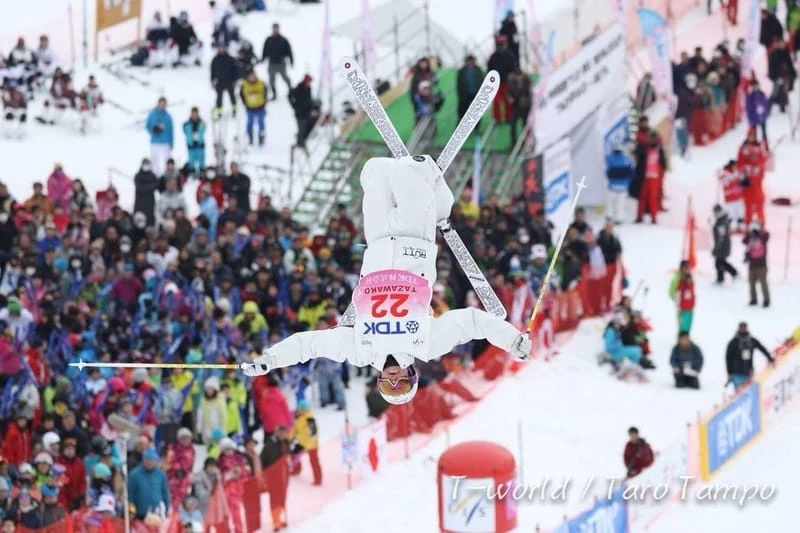
Laura Grasemann - Tazawako moguls World Cup - Photo by Taro Tanpo
In your career, when did you first attract sponsors' attention? How did you do this?
My first sponsor was Dynastar skis. By that time, they decided to sell a mogul ski, and thus wanted to get into mogul skiing business. They preferred a young athlete, they could cooperate with for many years. I was in my teens and a promising young athlete with several podiums in Europa Cup competitions and some World Cup starts. Besides, the one responsible for sponsoring at Dynastar by that time was the boyfriend of a girl I used to compete within alpine skiing, when I was a child. This was how they got aware of me. I fit what they wanted to have as an athlete, and I, in contrast, was happy to have Dynastar as a sponsor. The sponsorship lasted for many years and I still stop by for a chat whenever I meet someone from the Dynastar company I have been working with.
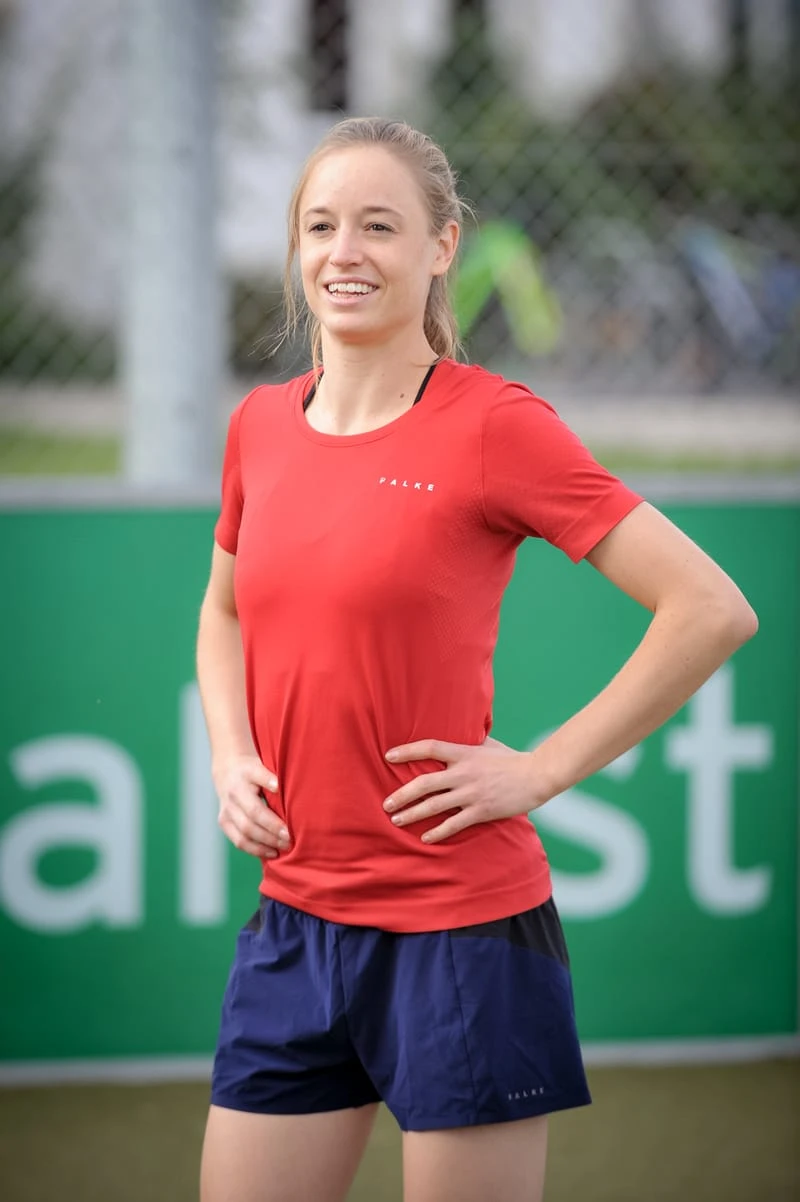
Laura Grasemann - Quattroball Turnier 2018
Could you tell us about your sponsors? What are the brands that you collaborate with?
My head sponsor is Falke. They are famous for their amazing socks, but I can tell, that their sportswear is of excellent quality as well. They support me with money and sports clothing. In return, I wear their logo on my helmet/cap, and I test their sports gear and give them feedback from an athlete’s point of view. I've been working with Falke since 2014, and I highly appreciate the partnership. I love their products and so I can present them and advertise them with persuasion. Additionally, the guys that are responsible for the partnership at the Falke side are coaches and sportsmen themselves, so there are a very good personal basis and a great understanding for sports from their side.
My second big sponsor is LösslImmobilienpool Bad Tölz. The head of the company is a freestyle lover I've known for many years. We have an open way of talking to each other what everyone expects and what can be done. I wear the LösslImmobilienpool on my jacket, which gets the brand into media like TV or newspaper. This is hardly possible for small companies in other ways, as TV advertisements are extremely expensive. I work with LösslImmobilienpool since last year.
The Willy Robert Pitzer Stiftung supports me with a scholarship. I got into touch with them in an event honoring student athletes last year. I talked about fairness in sports and sport funding and the director liked the story I told, so they decided to support me. As it is a foundation, this is not a classic sponsorship, but I still have their logo on my jacket to raise publicity for the foundation.
Denis Klefenz trades Hanse Merkur insurances and is a very active and sports-loving person himself. I've been working with him for several years now and it is always great to exchange experiences and stories with him. He supports several regional athletes and teams of every kind of sports. Sponsoring "their" athletes and being involved in the local public life gives him support and trust from the people living in the area that may be his customers.
Zipline and Bomber are two brands from the USA that support me with poles and skis, respectively. In the USA, freestyle skiing is a lot more popular than in Germany. Both brands are very much into social media marketing and share most of my posts where their product is seen. Additionally, I show my poles and skis whenever competitions are broadcasted and so they get additional media coverage. For both brands, I know the CEOs personally, and they always give me the feeling of acknowledgment of my achievements. Especially Chuck Heidenreich from Zipline has proven to be not only a sponsor but a person I can rely on and who always helps me the best he can. As I have the choice of taking whatever I like best for skis and poles, I feel very comfortable in recommending my recent sponsors’ products.
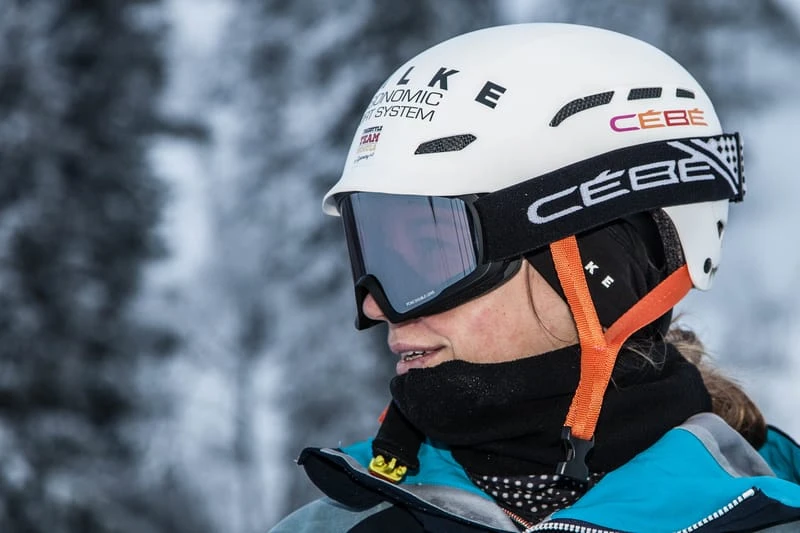
Laura Grasemann - Photo by Harald Marbler
Cebe supports me with helmets and goggles. Especially the helmet is the best fitting one I’ve ever had.
Tecnica provides me with ski boots. Ski boots are probably the most underestimated part of a skier’s equipment, they have to match perfectly to the skier’s needs. My Tecnica boots are combined with my insoles by tailored fits which are custom 3D print.
I have a similar agreement with all equipment sponsors; their products are seen on TV and other media and additionally I present them on my social media accounts. Most of them are extremely happy about feedback and in return, they do their best to find the best solutions to my needs.
Our team sponsors Zanier gloves and Rutt Mogul Pants provide the whole team with gloves and Skiwear respectively. The sponsoring contracts mainly rely on social media advertising. Additionally, they share our posts about their products and raise the popularity of the whole team.
Last but not least I work together with a local sports shop, Sport65, they take care about my equipment and keep it in a good shape and support me with finding sponsors and supporters. They have a very good network in the sports brand community and have a very good expertise. In return, they advertise that I, as a World Cup skier, trust them by getting my equipment prepared by them. This partnership is probably the oldest, I first came to the shop when I was around 11 years old to buy my first ever mogul skis.
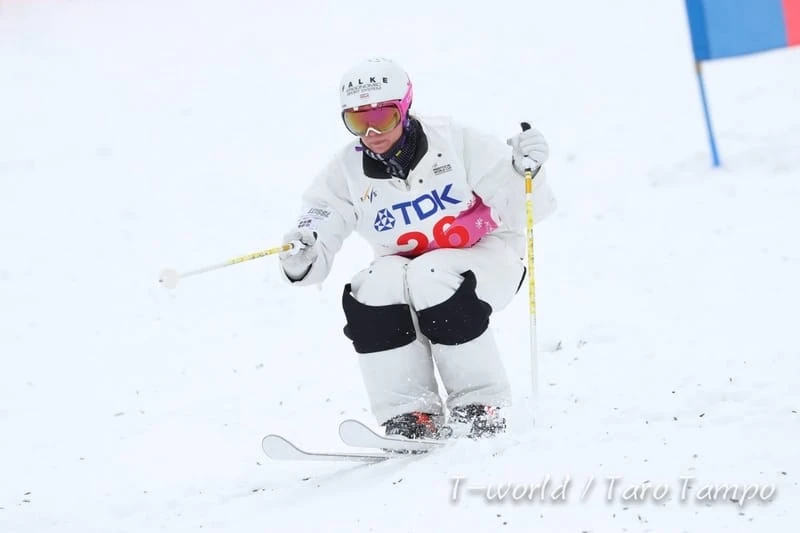
Laura Grasemann - Tazawako moguls World Cup - Photo by Taro Tanpo
What contributions does sponsor brands provide freestyle skiers? What do sponsors expect and demand from freestyle skiers?
Contributions of sponsors and their demands vary greatly. Some brands support freestyle skiers on a financial basis, others provide equipment. For sure, there is a difference in the brand’s demand from the skier, depending on what they provide. Most equipment sponsors are happy if their products are worn or shown publicly. Additionally, they appreciate when linked on Facebook, Instagram posts or a webpage. Most of the brands do not want any obvious advertisement. In most cases, brands like it better if the boot, or jacket, or helmet is simply shown on various pictures. Some are happy to just post pictures of the athletes they support on their own pages.
Some brands have meetings or public events where they like the athlete to take part. Additionally, an athlete can think of various ways on how to support the sponsor, like making videos, giving talks, autograph events, and various other possibilities. The more creative an athlete is, the more likely he or she will attract a sponsor’s attention.
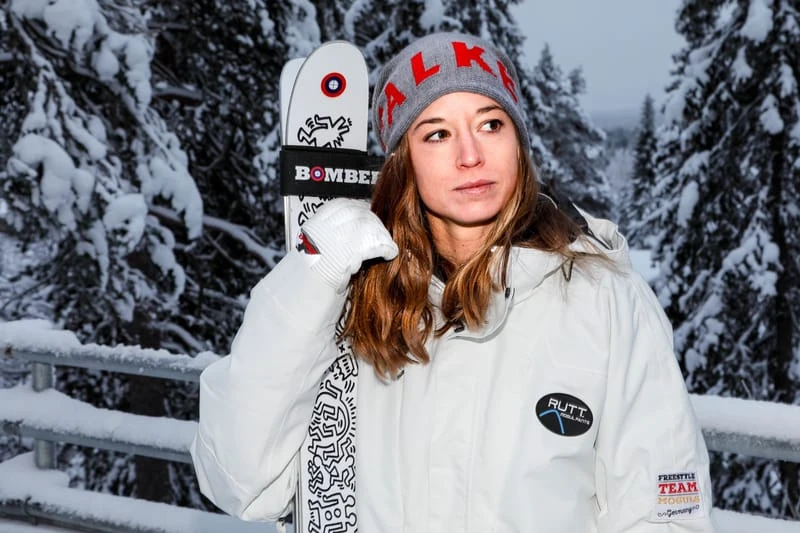
Laura Grasemann - Photo by Harald Marbler
How many different platforms can freestyle skiers represent their sponsors throughout the year?
There are obvious platforms where freestyle skiers can represent their sponsors like competitions, TV reports, newspaper and magazine articles, or social media. Especially social media has a growing impact on the representation of sponsors. While TV reports and newspaper articles are quite condensed during competition season, and less during the rest of the year, social media give the possibility to represent sponsors all year. Besides, it is quite often underestimated how sponsors are represented during everyday training. It is quite spectacular to see freestyle skiers ski during their everyday training, and we usually have quite a lot of spectators standing aside our course, watching us train. They look at what skis we ski on, they ask you on the lift what ski boots you recommend, they see the patches with the sponsor logos on your jacket. As athletes are more approachable during training, people frequently ask you about your sponsors, and the representation of the sponsors is in most cases not considered as direct advertisement and thus subtle. Besides, when doing physical training off-piste, freestyle skiers, and most athletes in general, quite often draw the attention of the public towards them. When I go to the fitness, people are quite often stoked how a girl of my size and shape can do deadlifts with that much weight, or pushups, or run that fast. People notice, what kind of clothes I wear, what shoes I wear, and what kind of sponsors I represent.
What are your expectations from your sponsors?
Most important for me in a sponsorship is an equal and fair partnership. I don’t feel comfortable with sponsors that try to pay as little as possible and always try to push the limits, how much they can get out of the sponsorship. On the other hand, I feel bad just taking the money or product with the feeling that this is a kind donation and not a partnership where both sides profit. Besides, it is important for me that sponsors identify with me and my sport and see what effort it takes and acknowledge that doing the sport is the first priority and representing sponsors is second priority. For example, if a competition or training camp coincides with a sponsor’s event, I expect from a sponsor to not force me to skip training or a competition for their event.
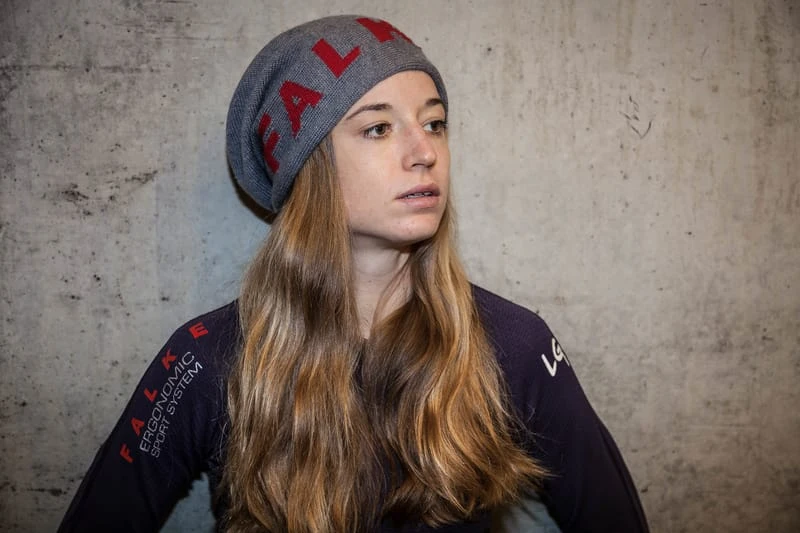
Laura Grasemann - Photo by Harald Marbler
What are the main factors that affect the continuity of sponsorship?
It is important that expectations are met for both sides. Therefore, it is crucial to communicate expectations in advance. A second important aspect is trust, and to be able to rely on the respective another partner. A personal connection may be helpful but is not strictly necessary in my point of view.
Do you have any advice for freestyle skiers who want to pursue a professional career?
Follow your passion. Do what you love. Work hard, set goals and pursue them, but never forget why you do this and what you actually love about your sports. Never let others set limits for you. Listen to their advice, listen to what they experienced, and what they learned, to not make the same mistakes over and over again, but never let them tell you what you can not do.

Laura Grasemann - Tazawako moguls World Cup - Photo by Taro Tanpo
What do you think about social media? How did it affect the popularity of freestyle skiing? How can our readers follow you?
Social media have a growing impact on sports and marketing in sports. It is a great opportunity for athletes especially in sports that do not have a lot of TV coverage to raise awareness and acquire supporters and sponsors. It is up to you as an athlete, what you want to share, how you want others to see you, and in what way you want to present yourself. The good thing about social media is that athletes do not depend on the goodwill of media, federations, or other entities for doing the appropriate marketing.
Followers in return can actively like, follow, and read what they are interested in, instead of just turning on TV watching what they get presented. This may lead to a shifted perception of what people like to see and know. In my opinion, social media have been, and still are a great opportunity especially for "young" sports like freestyle skiing to present themselves outside classic media. You can follow me on Instagram: lauragrasemann and on Facebook: facebook.com/laura.grasemann and our team on Instagram: Freestyleteamgermany and on facebook: facebook.com/freestyleteamgermany
Laura, we have talked about Mogul but there may be a lot of readers do not know about Mogul in detail. If it is possible, could you tell us about the fundamentals of Mogul before completing this informative interview?
Freestyle skiing is divided into several sub-disciplines: Halfpipe, Slopestyle, Big Air, Aerials, Ski Cross, and Mogul skiing. I do mogul skiing. A typical mogul course is around 200-250 m with bumps and two jumps. During competitions, skiers achieve a score which is composed of 60% mogul skiing technique, 20 % time, and 20% the jumps. For the jumps, the points for execution are multiplied by a coefficient which is determined by the difficulty of the jump. There are two formats of competition: Moguls, where every athlete gets a score up to 100 points. The skier with the highest score wins. During Dual mogul competitions, two skiers compete against each other and the better one advances to the next round. While Mogul skiing is an Olympic discipline since 1992, Dual moguls is not. Still, there are debates of adding Dual moguls to the Olympic Games. World Championships and World Cups have contests in both competition modes.
Thank you Laura for this enjoyable interview.
For more information, please click here and visit the website of Laura Grasemann
This interview was conducted in a Question-and-Answer format. The answers were checked for grammar and punctuation and published without any additional editing. Monday, November 19, 2018. All photos are the property of their respective owners.